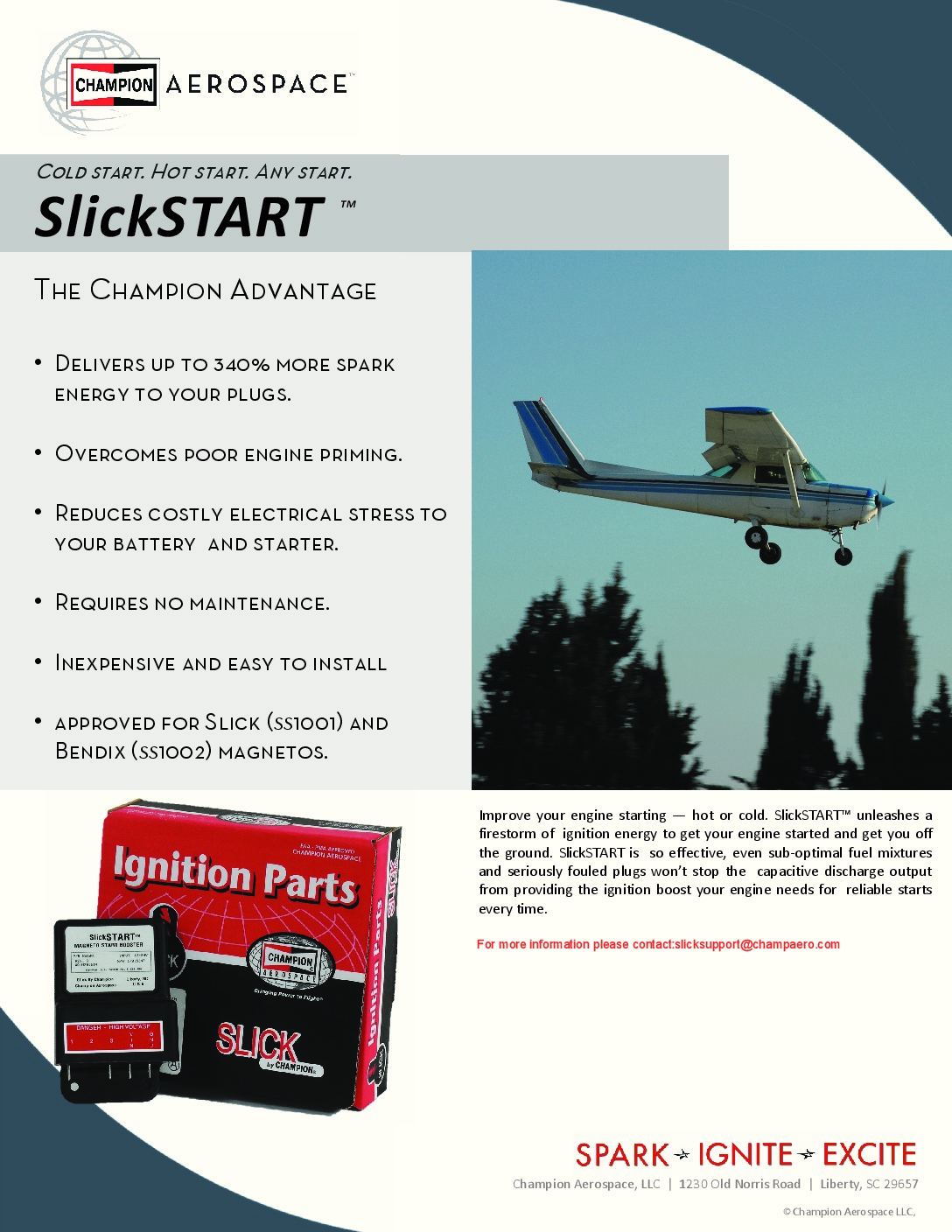Aircraft Magneto Service - Unless you're lucky enough to race a turbine or engine with an electronic ignition system, the internal combustion engines you race behind or in between are likely to be powered by a simple system involving a magnet, coil , a capacitor and contact points. When the rotating element in the accessory box rotates the magneto drive shaft, the magnet rotates and transmits electrical energy to the coil. When the points close, an electrical shock is sent from the coil to the respective spark plug wire to the attached spark plug and, kaboom, the cylinder ignites. At least that's how it's supposed to work.
Meanwhile, a second magneto does the same, preferably at the same time, to a second spark plug in the same cylinder. Between two magnetos and two spark plugs working in synchronization, the engine will deliver power with slightly more efficiency than a conventional engine with only one spark plug per cylinder, other things being equal. There is also a so-called "double" magneto, which uses only one driveshaft but fits two ignition harnesses. The design can simplify installation and maintenance, but at the cost of some redundancy. And redundancy is always good.
Aircraft Magneto Service

The trusty magneto has been around for as long as internal combustion engines have existed, and the core technology hasn't changed much in a century or so. With magnetos, spark-ignition engines do not need an aircraft electrical system. Instead, they generate the electrical power needed for ignition, as long as they are within specifications and correctly synchronized (timed) internally and with the engine. They are usually painted black and are mounted in the accessory box at the top rear of the engine. They must be easy to identify; These are the fittings with the ignition harness wires that go to the spark plugs.
Scintilla Bendix S4rn, S4ln, S6rn, S6ln Magneto Service Instructions.
Magnetos are a relatively simple electromechanical system, but they are subject to wear and tear as well as the stress of creating and releasing thousands of volts every minute. The nice thing about having a pair of magnetos is that they can go bad and the engine will still run, just not as well. I know this because I had the experience of a magneto failure, which ended in a safe landing at my home airport.
An important part of the pre-takeoff checklist for aircraft equipped with a typical spark-ignited engine is the magneto check. The checklist and/or aircraft documentation will specify the maximum RPM drop allowed in a magneto and the maximum difference between the two. If the magazines pass the test, we fly. What if they don't pass or there is no RPM drop on one or both chargers?
An RPM drop above specification can be accompanied by a rough running engine. If so, one or more spark plugs may be fouled with lead or even motor oil, and "burning" the contamination may solve the problem. To do this, set the charger switch back to the offending charger and carefully tilt the mix. You should see the RPM increase slightly as you lean. When it reaches its maximum, stop leaning and let the engine run at this mixture setting for a few seconds. If the roughness goes away, congratulations, you've successfully blown out the clogged socket. Return the mix control to your preferred setting and run the full mag check again. If the roughness does not disappear, the test has failed and the aircraft is not airworthy. Contact a mechanic for evaluation and/or repair, which can be as simple as replacing a bad spark plug.
If there is no RPM drop on one or both magnetos, something is wrong. Either the magneto switch is faulty or the P wire of the magneto is not grounded properly. In either case, the aircraft is not airworthy and repairs are needed, which could be as simple as replacing the P-wire.
Bendix Scintilla Df18rn And Df18ln Magneto Service Instructions Bookle
Magneto testing is not limited to pre-takeoff checklists. It's definitely allowed to run them in flight, but not at full power, especially if you're worried about a charger or spark plug. Back on the ground and before stopping, checking the magazines at low revs is a good post-flight measure. —J.B.
The magnetos are mechanically driven by the motor, so there are bearings and couplings to worry about. In order for electrical energy to flow from the coil to the spark plug wire, two pieces of metal, the contact points, must come into contact as the shaft rotates to transmit electricity. More possibilities of use. The inability of the spark to cross the contact points may be due to a faulty capacitor, an open circuit, or a short circuit failure. Due to its age, the coil may not provide proper voltage. Worn contact points are another mode of failure, possibly due to arcing, which can result from the capacitor or coil being out of specification.
The beauty of a magnet is its simplicity. When one fails, it's not dramatic and won't result in catastrophic engine failure unless both magazines fire dice at the same time. If this happens, the engine will stop running or could run rough (one or more cylinders missing). Losing a magneto will not blow the engine or send a valve through the engine or blow a cylinder head. The engine just won't make as much power. If you're lucky, you might not even notice the failure until the next mag check.

That being said, the problem with a failed magneto will only have one system to ignite the spark. With a bad magnet, it will produce a little less power, but now you are 100% dependent on the magnet left in the system, the one that just showed you isn't always reliable.
Opinion: Savvy Maintenance
A logical person would consider the fact that there is a good chance that both magnets were placed on the plane at the same time. Chances are they even share a common history of being from the same manufacturer or rebuild shop, and were installed by the same mechanic. Their shared heritage makes it safe to complete the flight or return to base, and consider other off-airport landing options along the way.
Once a magneto fails in flight, it is your responsibility to maintain altitude to maximize potential glide distance. Also keep power setting changes to a minimum (engine misfires occur more frequently during large power changes). If your engine hums with the remaining charger, leave it alone. When making power changes for the approach and landing, make them smooth and slow.
When my left magneto recently failed, my mechanic at home had a spare on the shelf, reserved for a pilot who frequently flies to Alaska. On those long drives, a spare magneto provided reassurance that it wouldn't get stuck in the ground in a remote location waiting for the next delivery of parts to arrive. However, you may still need someone to install it.
When a magnet breaks down, should an emergency be declared? Most likely. If the other magnet goes off, you'll wish you had it. If you are in busy airspace, controllers will give you priority processing, and if there are many aircraft circling at the scheduled airport, they will give you your slot in the circling, as it should be. Anything that helps you beat the odds and land safely should be used to your advantage. That's why the E word was invented.
American Bosch Sb9ru3 Magneto Parts & Service Inst
Do you need to preemptively land off the field? I wouldn't, unless in addition to the failed magneto you also have a bad motor. With just a bad charger, the engine will likely still run strong, just not as efficiently. If it is very difficult for the remaining magazine, a preventive landing at the nearest airport makes a lot of sense. If all goes well, but in a magazine, personally, I would proceed cautiously to the destination airport, as long as it is not hours away.
I always check my magazines, but not always on the floor. When operating on strips of gravel and dirt, high RPM starting can cause unwanted damage to the aircraft, including the propeller and tail. Once in the air, you can check that both chargers are working. This should not be done on a hill or on full power, but on a reduced power setting that puts less stress on the engine.
There are exceptions. I've heard of a case where the charger failed due to gear failure in the accessory box. Checking the magazine is what presented the failure, which resulted in metal components inside the engine falling to the bottom where they would be chewed up. If the pilot had continued to fly after the failed mag check, the engine would likely have suffered catastrophic failure due to bouncing of internals in the accessory box. Fortunately, the failed magnetic check resulted in the immediate grounding of the aircraft and disaster was averted. In this case, the failed magnet check was not actually due to the failure of the magneto itself, but rather to the deeper internal components of the engine that were spinning the magnetos.

When the magnetos are placed in the "Off" position, the P leads of the primary coil of the magneto are grounded. A magneto with a P wire connected to ground will not work
Scintilla Magnetos Vmn7d, Vmn7df, Vmn7df 5 & Vmn7dfa Service Instructi
Aircraft magneto tester, how does an aircraft magneto work, aircraft magneto service missoula, aircraft engine magneto, aircraft magneto ignition system, aircraft magneto timing light, aircraft magneto, aircraft magneto overhaul, magneto aircraft ignition, aircraft magneto repair, aircraft magneto switch, aircraft magneto parts
